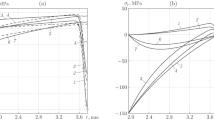Summary
The classical solution of the steady-state creep problem for a pressurized thick-walled cylinder is based on the power law constitutive equation. Several heat resistant steels show, however, the linear dependence of the creep rate on the applied stress within a certain stress range. In this paper we apply an extended constitutive equation which includes both the linear and the power law stress dependencies. The material constants are identified for the 9Cr1MoVNb steel at 600 °C. We recall the boundary value problem of steady-state creep for the thick cylinder under the plane strain condition. We present an approximate solution illustrating the stress redistributions as a result of the creep process. The analysis shows that for the certain range of the internal pressure both the linear and the power law creep must be taken into account. In this case the results according to the extended constitutive model essentially differ from the classical ones. The obtained solution is also applied to verify the developed user-defined creep material subroutine inside a commercial finite element code.
Similar content being viewed by others
References
Betten J. (2005). Creep Mechanics. Springer, Berlin
Naumenko K. and Altenbach H. (2007). Modelling of Creep for Structural Analysis. Springer, Berlin
Frost H.J. and Ashby M.F. (1982). Deformation-Mechanism Maps. Pergamon, Oxford
Kloc L., Sklenička V. and Ventruba J. (2001). Comparison of low creep properties of ferritic and austenitic creep resistant steels. Mater. Sci. Engng. A319–A321: 774–778
Kloc L. and Sklenička V. (2004). Confirmation of low stress creep regime in 9% chromium steel by stress change creep experiments. Mater. Sci. Engng. A387–A389: 633–638
Odqvist F.K.G. (1974). Mathematical Theory of Creep and Creep Rupture. Oxford University Press, Oxford
Skrzypek J.J. (1993). Plasticity and Creep. CRC Press, Boca Raton
ABAQUS, Benchmarks Manual: ABAQUS, Inc. (2006)
Leckie F.A. and Hayhurst D.R. (1977). Constitutive equations for creep rupture. Acta Metall. 25: 1059–1070
Kostenko, Y., Lvov, G., Gorash, E., Altenbach, H., Naumenko, K.: Power plant component design using creep-damage analysis. In: Proceedings of IMECE2006, pp. 1–10. Chicago: ASME, IMECE2006-13710 (2006)
Boyle J.T. and Spence J. (1983). Stress Analysis for Creep. Butterworth, London
Hayhurst D.R. (1972). Creep rupture under multiaxial states of stress. J. Mech. Phys. Solids 20: 381–390
Hyde T.H., Sun W. and Becker A.A. (2000). Failure prediction for multi-material creep test specimens using steady-state creep rupture stress. Int. J. Mech. Sci. 42: 401–423
Lee J.S., Armaki H.G., Maruyama K., Muraki T. and Asahi H. (2006). Causes of breakdown of creep strength in 9Cr-1.8W-0.5Mo-VNb steel. Mater. Sci. Engng. A428: 270–275
Polcik P., Sailer T., Blum W., Straub S., Buršik J. and Orlová A. (1999). On the microstructural developmenr of the tempered martensitic Cr-steel P91 during long-term creep–a comparison of data. Mater. Sci. Engng. A260: 252–259
Penny R.K. and Mariott D.L. (1995). Design for Creep. Chapman & Hall, London
Dyson B.F. and McLean M. (2001). Micromechanism-quantification for creep constitutive equations. In: Murakami, S. and Ohno, N. (eds) IUTAM Symposium on Creep in Structures, pp 3–16. Kluwer, Dordrecht
Kowalewski Z.L., Hayhurst D.R. and Dyson B.F. (1994). Mechanisms-based creep constitutive equations for an aluminium alloy. J. Strain Anal. 29(4): 309–316
Perrin I.J. and Hayhurst D.R. (1994). Creep constitutive equations for a 0.5Cr-0.5Mo-0.25V ferritic steel in the temperature range 600–675°C. J. Strain Anal. 31(4): 299–314
Odqvist F.K.G. and Hult J. (1962). Kriechfestigkeit metallischer Werkstoffe. Springer, Berlin
Backhaus G. (1983). Deformationsgesetze. Akademie-Verlag, Berlin
Becker A.A., Hyde T.H., Sun W. and Andersson P. (2002). Benchmarks for finite element analysis of creep continuum damage mechanics. Comput. Mater. Sci. 25: 34–41
Author information
Authors and Affiliations
Corresponding author
Additional information
Dedicated to Professor Franz Ziegler on the occasion of his 70th birthday
Rights and permissions
About this article
Cite this article
Altenbach, H., Gorash, Y. & Naumenko, K. Steady-state creep of a pressurized thick cylinder in both the linear and the power law ranges. Acta Mech 195, 263–274 (2008). https://doi.org/10.1007/s00707-007-0546-5
Received:
Accepted:
Published:
Issue Date:
DOI: https://doi.org/10.1007/s00707-007-0546-5




